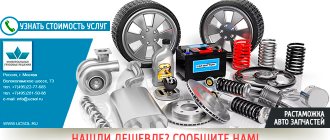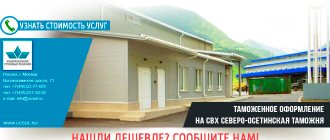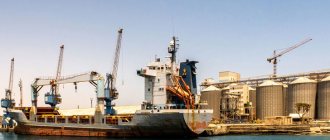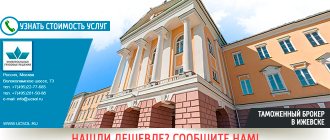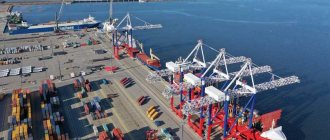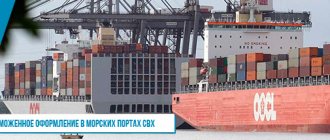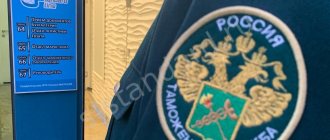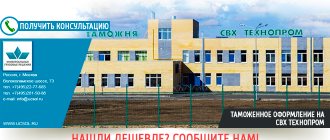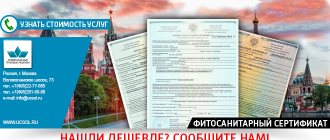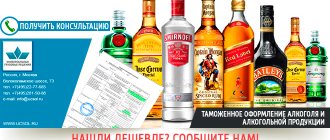Medical equipment is one of the most complex and preferential categories of goods subject to customs clearance. Use the services of a certified customs representative of LCM Group to carry out customs clearance as profitably as possible and quickly release the goods into free circulation in the Russian Federation.
The amount of customs duties, the cost of services of LCM Group specialists and the list of necessary documents can be found by calling the holding company or through the online application form.
Stages of customs clearance
During the customs clearance process, declarants and the customs service perform several steps.
- The declarant prepares documents for the consignment of goods and submits them to the customs service.
- The customs inspector checks the documents for compliance with the law, whether customs duties have been paid or not, and whether permits are present. The responsibility for preparing documents can be transferred to the customs broker, who will also calculate the duty in accordance with the product code according to the nomenclature of the Commodity Nomenclature of Foreign Economic Activity, fill out the declaration, and optimize the amount of payments.
- After submitting the documentation, the cargo undergoes a comprehensive inspection. The declarant or customs representative may accompany the cargo inspection procedure. If the customs inspector has no complaints about the documents, cargo or vehicle, the goods are released for free circulation and can be removed from the temporary storage warehouse.
Penalties for failure to comply with registration requirements
For the sale of medical devices that have not passed the mandatory state registration procedure, there are serious sanctions in Russia, provided for in Article 6.33 of the Code of Administrative Offenses of the Russian Federation.
| Category of perpetrator | Sanctions for the production or sale of a medical device that is not registered | Sanctions for selling an unregistered medical device via the Internet |
| Ordinary employee | 70-100 t.r. | 75-200 t.r. |
| Management representative | 100-600 t.r. | 150-600 t.r. |
| IP | 100-600 t.r. or stop work up to 90 days | 150-600 t.r. or stop work up to 90 days |
| Entity | 1-5 million rubles or stop work for up to 90 days | 2-6 million rubles or stop work up to 90 days |
Common mistakes when applying on your own
The process of interaction with regulatory government agencies is not easy and often does not bring the expected result. The main mistakes that applicants make when applying to Roszdravnadzor on their own are:
- incomplete or incorrectly completed package of documents;
- failure to carry out all necessary tests;
- violation of application deadlines;
- failure to provide additional documentation at the request of the department;
- other errors.
Features of customs clearance
Medical equipment differs from other goods in that tax benefits are established for this category of goods. Some types of equipment are not subject to VAT at all, while other products are subject to reduced VAT, at a rate of 10%, instead of the standard 20%.
ATTENTION! We work only with legal entities.
The list of medical products that are not subject to value added tax is established by Decree of the Government of the Russian Federation of September 30, 2015 No. 1042. This list includes vital equipment. Medical products specified in the list of Government Decree No. 688 of September 15, 2008 are eligible for preferences for part of the value added tax.
According to practice, the bulk of medical goods are included in the list of partially exempted from VAT. But in order to take advantage of VAT preferences, you need to obtain a registration certificate from Roszdravnadzor. The fact is that in Russia only medical equipment that is included in the State Register of Medical Devices can be used. If the equipment has never been registered in Russia, then it must be imported for registration purposes. To do this, a permit for a one-time import of equipment is issued from Roszdravnadzor. It is valid for a certain period.
Thus, the declarant must provide a package of documents, which includes:
- registration certificate of Roszdravnadzor;
- declaration of conformity;
- certificate of conformity GOST R;
- ISO international quality certificate;
- invoice or invoice;
- shipping documents;
- declaration.
The OKPD code specified in the permitting documents must coincide with that established by the regulatory act. Then, of all customs payments, the declarant pays only the customs clearance fee.
Note! Preferences do not apply to medical products. Therefore, registration documents must indicate: “medical equipment products.” The concepts of medical equipment and medical products are clearly separated. The registration certificate indicates in brackets that the registered medical product is a product of medical equipment.
If the registration certificate contains the terms “set” or “composition”, all components must be present when declared. They must also be properly registered and indicated on the marketing authorization.
The names indicated in documents, for example, certificates of conformity, registration certificate, may not coincide with those that correspond to OKPD codes. This feature is noted in the letter of the Ministry of Health of the Russian Federation dated March 25, 2002 No. 2510/2698-02-23. In addition, the same letter indicates that the six-digit OKPD code, established by Government Decree and having two zeros at the end, can coincide with the actual one only at the level of the first four characters.
Important! The registration certificate is valid for an unlimited period. But it is indicated that this document is valid until the moment when changes are made to the Federal Law that regulates the issuance of certificates.
It is difficult for the declarant to understand all the subtleties; this requires experience. We are ready to take on all obligations.
You need to know that the Resolution of September 15, 2008 contains two lists of goods. One is compiled according to OKPD codes, and the other according to HS codes, therefore, if a specific product is not on one list, it may appear on another list.
The peculiarity of customs clearance of medical equipment is that the customs inspector usually closely studies the declaration and looks for inconsistencies. He has the right to disagree with the code assigned to the product and indicate a different code. In this case, payments may be written off in full.
Problems arise if an error is made when preparing documents:
- an incomplete package was provided;
- the wording is inaccurate;
- the HS code or OKPD code is incorrectly selected;
- The declaration was filled out incorrectly.
Errors, inaccuracies and typos lead to cargo downtime in the warehouse and unnecessary costs.
Planned changes in the procurement of medical devices
09.09.2021 The Ministry of Industry and Trade issued clarifications to RF PP No. 1432 and published draft amendments to RF PP No. 878 in connection with the updated regulations. The Department proposes to exclude paragraphs 4 and 5 from Resolution No. 878 - they are relevant only if there are restrictions on admission under paragraph 3 of Resolution No. 878, and such restrictions are no longer established. In addition, the draft amendments made it possible to confirm the country of origin with a declaration (at the application stage) and a copy of the ST-1 certificate (at the contract execution stage) for various OKPD2 for the supply of medical equipment:
- 26.51.53.140;
- 26.51.53.190;
- 26.51.70.110;
- 26.60.11.111;
- 26.60.11.112;
- 26.60.11.113;
- 26.60.12.110;
- 26.60.12.129;
- 32.50.1, etc.
The transition period under the “second wheel” rule will last from 08/31/2021 to 12/31/2022. Before its completion, participants confirm the origin (from the Russian Federation and the EAEU) of medical equipment with a copy of the ST-1 certificate. And as part of the application, it is necessary to indicate the numbers of register entries from the GISP (domestic or Eurasian register) and information about localization points (RF RF No. 719 dated July 17, 2015, decision of the Council of the Eurasian Economic Commission No. 105 dated November 23, 2020).
The department plans to adjust Government Resolution No. 102 of 02/05/2015. Firstly, ultrasonic surgical devices will be excluded from the resolution (OKPD2 26.60.12.132, 26.60.13.130, 26.60.13.190) and individual glucometers will be returned (OKPD2 26.51.53.19). They were excluded from the list after the introduction of PP No. 1432.
Secondly, in 2022 the documentary procedure for bidding will change. From 01/01/2022, procurement documentation for conducting electronic procedures is no longer required (360-FZ dated 07/02/2021). All necessary information is indicated in the notice, which is published in the Unified Information System.
Since April 2021, the Russian government has also been considering a draft resolution on introducing restrictions and conditions for the approval of stents for coronary arteries. If it comes into force, then customers will have to reject all applications offering to supply foreign products. Such participants are rejected if there is at least one application that fully complies with the requirements of the documentation and notification. The country of manufacture of the goods is certified in a standard certificate or a conclusion confirming the production of products in the Russian Federation.
Medical equipment certification
Medical equipment must comply with domestic GOST requirements. Certification of most medical equipment is carried out in an accredited certification center in the form of issuing a declaration of conformity, with the exception of safety glasses, for which a certificate of conformity is issued.
In addition to mandatory certification, medical equipment can undergo voluntary certification. A voluntary certificate inspires greater consumer confidence and expands the ability to find markets and partnerships.
Only a domestic company can apply for a declaration of conformity, so foreign manufacturers must act through a representative. In addition to the application, the certification center sells:
- OGRN, TIN, charter of the enterprise;
- Company details;
- equipment description;
- foreign trade contract.
In addition, you need to obtain a certificate of state registration from Rospotrebnadzor. Without this document, declarations and certificates of conformity are not issued. Certification is carried out in the form of laboratory tests of product samples, as a result of which a test report is drawn up, and on its basis a main document is issued.
Advantages of cooperation with us
The Center for Registration of Medical Devices has been working with foreign manufacturers of medical equipment for many years. Our specialists have thoroughly studied the procedure for importing and customs clearance of such equipment, so we are ready to guarantee our clients a trouble-free and quick completion of all necessary formalities, including obtaining permission from Roszdravnadzor.
We will make sure that you receive all the required customs benefits and preferences that are available for your product category. As a result of cooperation with us, the daunting and lengthy process of interaction with government agencies will take you a minimum of time. As a result, you will have the opportunity to take a worthy place in the market by offering your customers a high-quality product that has a well-deserved reputation in the world.
Shipping
Medical equipment can be transported by sea, air, road, and rail. However, transportation regulations must be followed as medical equipment is often fragile and expensive. It is important to pack it correctly. The packaging must protect the device from vibration and shaking, and mechanical damage. Avoid exposure to extreme temperatures and moisture.
If the cargo is large, specialized equipment is used to load and unload it. The packaging should be marked, which indicates how to properly transport the cargo, how to unload and load it correctly.
Motor transport with special equipment transports medical equipment over short distances of up to 700 km. Thus, for example, it is possible to deliver a particular device from the airport to the consignee. For transportation over long distances, rail transport is used. In addition to being more convenient, it is also a cost-effective option. It is cheaper to transport equipment by sea, but loading and unloading medical equipment is difficult. Expensive medical devices should be delivered by air, since in this case the risks of damage are minimized. Devices such as ultrasound, tomographs, and X-ray machines are especially sensitive to moisture. They should not be sent by sea. Monitors and laboratory equipment are too fragile to be transported in a container or the back of a vehicle. At a minimum, they should be carefully packed.
SB Cargo services
A declarant who is not closely familiar with customs legislation and has little idea of how the customs clearance procedure takes place will certainly encounter difficulties.
In this case, it is difficult to clear medical equipment through customs without the help of third parties. The customs broker SB Cargo will eliminate the need to study legislation and will take into account all the nuances when filling out the documentation. The specialists who work at SB Cargo are licensed and act in accordance with the law, monitoring the latest changes. Services are provided under a pre-executed agreement. We avoid hidden fees and strive to ensure customer satisfaction. We defend the client’s rights in customs, we know how to quickly clear cargo through customs, and we provide free consultations on customs clearance and transportation issues. Call us by phone or write by email
Explanations on the topic
| Main points | Document details | Download |
| On the application of restrictions on foreign medical products in public procurement according to Government Decree No. 102 of 02/05/2015 | Joint letter of the Ministry of Finance dated May 22, 2018 No. 24-03-06/47606, Ministry of Industry and Trade dated May 22, 2018 No. TsS-31570/19, Ministry of Health dated June 29, 2018 No. 25-3/10/2-4204, FAS dated May 29, 2018 No. RP/38817/18 |
About the author of this article
Alexandra ZadorozhnevaAccountant, project expert Practicing accountant. I have been working since the beginning of my studies at the university. I have experience in both commerce and budgeting. From 2006 to 2012 she worked as an accountant-cashier and personnel officer. From 2012 to the present - chief accountant in a budgetary institution. In addition to direct accounting, I am involved in purchasing and economic planning activities. I have been writing feature articles for specialized publications for 4 years.
Other publications by the author
- 2021.12.02News and changesProcedure for acceptance and authorization of expenses: new clarifications from the Treasury
- 2021.12.02News and changesThe Treasury approved a new order on opening personal accounts from 01/01/2022
- 2021.12.02 Procurement control Approved a list of information for risk analysis during internal state financial control
- 2021.11.30MiscellaneousWork in January: when to work as a contract manager and how to plan the beginning of the year

